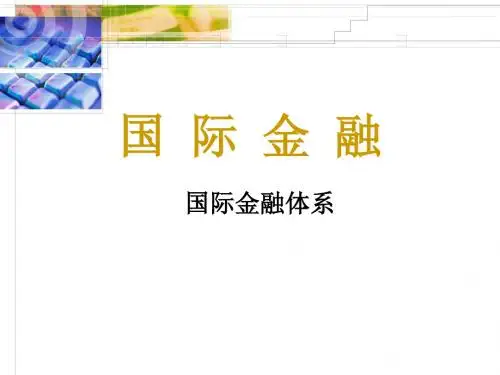chapter3(国际金融体系)
- 格式:ppt
- 大小:2.66 MB
- 文档页数:4
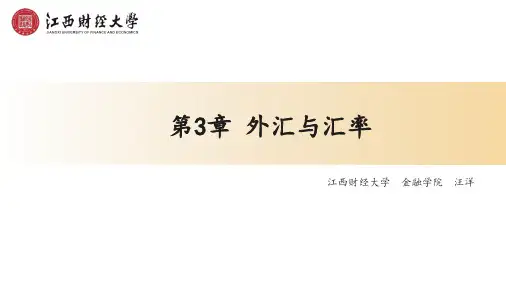
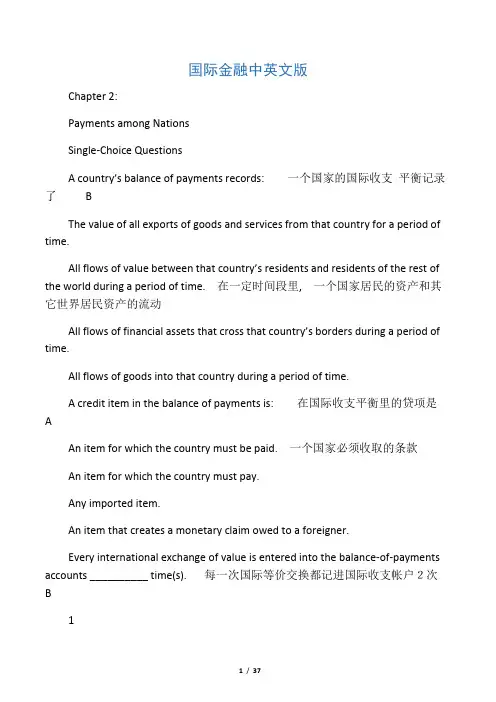
国际金融中英文版Chapter 2:Payments among NationsSingle-Choice QuestionsA country’s balance of payments records: 一个国家的国际收支平衡记录了 BThe value of all exports of goods and services from that country for a period of time.All flows of value between that country’s residents and residents of the rest of the world during a period of time.在一定时间段里,一个国家居民的资产和其它世界居民资产的流动All flows of financial assets that cross that country’s borders during a p eriod of time.All flows of goods into that country during a period of time.A credit item in the balance of payments is: 在国际收支平衡里的贷项是AAn item for which the country must be paid.一个国家必须收取的条款An item for which the country must pay.Any imported item.An item that creates a monetary claim owed to a foreigner.Every international exchange of value is entered into the balance-of-payments accounts __________ time(s). 每一次国际等价交换都记进国际收支帐户2次B1234A debit item in the balance of payments is: 在国际收支平衡中的借项是BAn item for which the country must be paid.An item for which the country must pay.一个国家必须支付的条款Any exported item.An item that creates a monetary claim on a foreigner.In a nation's balance of payments, which one of the following items is always recorded as a positive entry? D在国际收支中,下列哪个项目总被视为有利条项Changes in foreign currency reserves.Imports of goods and services.Military foreign aid supplied to allied nations.Purchases by foreign travelers visiting the country.国外游客在本国发生的购买The sum of all of the debit items in the balance of payments: 在收支平衡中,所有贷项的总和 BEquals the overall balance.Equals the sum of all credit items.等于所有借项的总和Equals the sum of credit items minus errors and omissions.Which of the following capital transactions are entered as debits in the U.S. balance of payments? 下列哪个资本交易在美国的收支平衡中当作借项? BA U.S. resident transfers $100 from his account at Credit Suisse in Basel (Switzerland) to his account at a San Francisco branch of Wells Fargo Bank.A French resident transfers $100 from his account at Wells Fargo Bank in San Francisco to his Credit Suisse account in Basel.一个法国居民在旧金山的Fargo Bank用其帐户转帐100美金到位于巴塞尔的瑞士信贷户口A U.S. resident sells his IBM stock to a French resident.A U.S. resident sells his Credit Suisse stock to a French resident.An increase in a nation's financial liabilities to foreign residents is a: 一个国家对另一个国家金融负债的增加是一种CReserve inflow.Reserve outflow.Capital inflow.资本流入Capital outflow.___A_______ are money-like assets that are held by governments and that are recognized by governments as fully acceptable for payments between them. 官方国际储备资产是一种类似于钱的资产,这种资产由政府掌握并作为政府间的一种支付手段得到充分认可.Official international reserve assets 官方国际储备资产Unofficial international reserve assetsOfficial domestic reserve assetsUnofficial domestic reserve assetsWhich of the following is considered a capital inflow? 下列哪项被视为资本流入 AA sale of U.S. financial assets to a foreign buyer.美国一金融资产卖给一外国买家A loan from a U.S. bank to a foreign borrower.A purchase of foreign financial assets by a U.S. buyer.A U.S. citizen’s repayment of a loan from a foreign bank.In a country’s balance of payments, which of the following transactions are debits?一个国家的收支平衡表中,哪个交易属于借项? ADomestic bank balances owned by foreigners are decreased.外国人拥有的国内银行资产的下降Foreign bank balances owned by domestic residents are decreased.Assets owned by domestic residents are sold to nonresidents.Securities are sold by domestic residents to nonresidents.The role of ___D_______ is to d irect one nation’s savings into another nation’s investments: 资金流的作用是指导一个国家的储蓄进入到另一个国家的投资Merchandise trade flowsServices flowsCurrent account flowsCapital flows资金流Capital account.Current account.经常账目(户)Trade balance.Official reserve balance.The net value of flows of financial assets and similar claims (excluding official international reserve asset flows) is called the: 金融资产和类似的资产(官方国际储备资产流除外)的净值流叫AFinancial account.金融帐Current account.Trade balance.Official reserve balance.The financial account in the U.S. balance of payments includes: 美国国家收支表中的金融帐包括: BEverything in the current account.U.S. government payments to other countries for the use of military bases.美政府采用其它国家军事基地所需支付款项Profits that Nissan of America sends back to Japan.New U.S. investments in foreign countries.AU.S. resident increasing her holdings of a foreign financial asset causes a:一个美国居民增持一外国金融资产会引起DCredit in the U.S. current account.Debit in the U.S. current account.Credit in the U.S. capital account.Debit in the U.S. capital account.美国资本帐的借帐A foreign resident increasing her holdings of a U.S. financial asset causes a:一个美国居民增持本国一金融资产会引起 CCredit in the U.S. current account.Debit in the U.S. current account.Credit in the U.S. capital account.美国资本帐的贷帐Debit in the U.S. capital account.A deficit in the current account: 经常帐户中的赤字 ATends to cause a surplus in the financial account.会导致金融帐中的盈余Tends to cause a deficit in the financial account.Has no relationship to the financial account.Is the result of increasing exports and decreasing imports.In September, 2005, exports of goods from the U.S. decreased $3.3 billion to $73.4 billion, and imports of goods increased $3.8 billion to $144.5 billion. This increased the deficit in:20xx年8月,美国商品出口降低了33亿美元,共734亿美元;商品进口上升到1145亿美元,上长了38亿.这样增加了哪个方面的赤字?CThe balance of payments.The financial account.The current account.经常帐户Unilateral transfers.Which of the following would contribute to a U.S. current account surplus? 以下哪项有助于美国现金帐的盈余? BThe United States makes a unilateral tariff reduction on imported goods.The United States cuts back on American military personnel stationed in Japan.美国削减在日本的军事人员U.S. tourists travel in large numbers to Asia.Which of the following transactions is recorded in the financial account?以下哪个交易会被当作金融帐AA Chinese businessman imports Ford automobiles from the United States.A U.S. tourist spends money on a trip to China.The New York Yankees are paid $10 million by the Chinese to play an exhibition game in Beijing, China.If a British business buys U.S. government securities, how will this be entered in the balance of payments? 如果一英国商人购买了美国政府的债券,那么这个交易在收支平衡表中会被当作是? CIt will appear in the trade account as an import.It will appear in the trade account as an export.It will appear in the financial account as an increase in U.S. assets held by foreigners.会被当作是外国人所有的美国资产增长It will appear in the financial account as a decrease in U.S. assets held by foreigners.In the balance of payments, the statistical discrepancy or error term is used to: 在收支平衡表中, 统计差异与错误项目会用来确保借帐总和跟贷帐总和一致 AEnsure that the sum of all debits matches the sum of all credits.Ensure that imports equal the value of exports.Obtain an accurate account of a balance-of-payments deficit.Obtain an accurate account of a balance-of-payments surplus.Official reserve assets are: 官方储备资产是 BThe gold holdings in the nation’s central bank.Money like assets that are held by governments and that are recognized by governments as fully acceptable for payments between them. 官方国际储备资产是一种类似于钱的资产,这种资产由政府掌握并作为政府间的一种支付手段得到充分认可Government T-bills and T-bonds.Government holdings of SDR’sGold.Special Drawing Rights.IMF Reserve Positions.Foreign Currencies.外汇(币)The net accumulation of foreign assets minus foreign liabilities is: 海外净资产的积累减去外债等于CNet official reserves.Net domestic investment.Net foreign investment.国外投资净值Net foreign deficit.A country experiencing a current account surplus: 一个国家经历经常帐户的盈余 BNeeds to borrow internationally.Is able to lend internationally.就有能力向外放贷Must also have had a surplus in its "overall" balance.The ___C_______ measures the sum of the current account balance plus the private capital account balance. 官方结算差额是指经常帐户余额的总和加上私人资本帐(B=CA+FA,FA:为非官方投资和储备)Official capital balanceUnofficial capital balanceOfficial settlements balance官方结算差额Unofficial settlements balanceIf the overall balance is in __A________, there is an accumulation of official reserve assets by the country or a decrease in foreign official reserve holdings of the country's assets. 如果综合差额处于盈余,那么会出现本国官方储备资产的积累或者国外官方储备的减少(B=CA+FA,B+OR=0,OR:官方储备金额)Surplus盈余DeficitBalanceForeign handsWhich of the following is the current account balance NOT equal to? 以下哪项不等同于现金帐 DThe difference between domestic product and domestic expenditure.The difference between national saving and domestic investment.Net foreign investment.The difference between government saving and government investment. 政府储蓄与政府投资的差值True/False QuestionsCapital inflows are debits and capital outflows are credits. 资金流入是借项,资金外流是贷项The net flow of financial assets and similar claims is the private current account balance. 金融资产和类似的资产的净值叫经常帐目余额The majority of countries' official reserves assets are now foreign exchange assets, financial assets denominated in a foreign currency that is readily acceptable in international transactions. (T)大部份官方储备资产作为以外汇资产和金融资产为命名的外币在世界上交易与流通.A country's financial account balance equals the country's net foreign investment.一个国家的金融帐差额相当于一个国家的净国外投资A country has a current account deficit if it is saving more than it is investing domestically.一个国家如果在国内的储蓄比投资要大,那么会出现经常账目赤字The official settlements balance measures the sum of the capital account balance plus the public current account balance. 官方结算差额是资金帐户余额的总额加上公共经常帐户余额A nation's international investment position shows its stock of international assets and liabilities at a moment in time. (T)一个国家的国际投资状况反映出它在特定时间里的国际资产股份以及债务情况.A nation is a borrower if its current account is in deficit during a time period. (T)在一段时间内,如果一个国家的经常帐出现赤字,那么它就是借方.A nation is a debtor if its net stock of foreign assets is positive. 如果一个国家的国外资产净储备是正数,那么它是借方(债务方)A transaction leading to a foreign resident increasing her holdings of a U.S. financial asset will be recorded as a debit on the U.S. financial account.如果一项交易引起一外国居民增持美国金融资产的股份,那么这项交易在美国金融帐中会被当作借项A credit item is an item for which a country must pay. 贷项是指一个国家必须还款的条项Gold is a major reserve asset that is currently often used in official reserve transactions. 黄金作为主要的储备资产,常被用在官方储备交易当中.The current account balance is equal to the difference between domestic product and national expenditure.(T)经常项目余额等于国民生产与国民支出的差额In 2007 U.S. households, businesses and government were buying more goods and services than they were producing.(T)____年,美国家庭,商业,政府购买的商品和服务比他们生产(商品和服务)的要多.6。
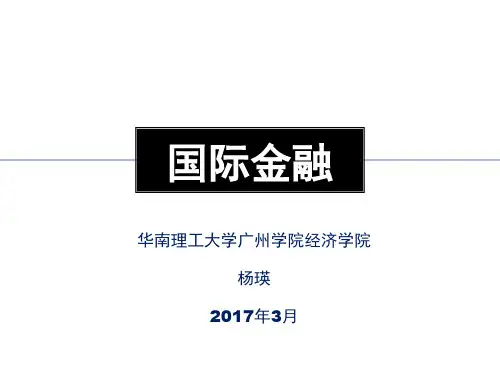

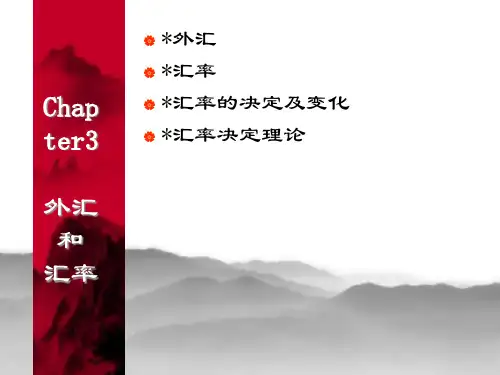
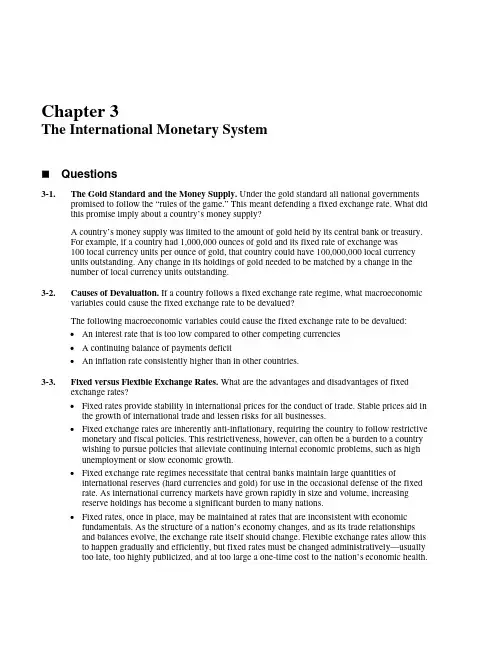
Chapter 3The International Monetary SystemQuestions3-1. The Gold Standard and the Money Supply. Under the gold standard all national governments promised to follow the “rules of the game.” This meant defending a fixed exchange rate. What did this promise imply about a country’s money supply?A country’s money supply was limited to the amount of gold held by its central bank or treasury.For example, if a country had 1,000,000 ounces of gold and its fixed rate of exchange was100 local currency units per ounce of gold, that country could have 100,000,000 local currencyunits outstanding. Any change in its holdings of gold needed to be matched by a change in thenumber of local currency units outstanding.3-2. Causes of Devaluation. If a country follows a fixed exchange rate regime, what macroeconomic variables could cause the fixed exchange rate to be devalued?The following macroeconomic variables could cause the fixed exchange rate to be devalued:•An interest rate that is too low compared to other competing currencies• A continuing balance of payments deficit•An inflation rate consistently higher than in other countries.3-3. Fixed versus Flexible Exchange Rates. What are the advantages and disadvantages of fixed exchange rates?•Fixed rates provide stability in international prices for the conduct of trade. Stable prices aid in the growth of international trade and lessen risks for all businesses.•Fixed exchange rates are inherently anti-inflationary, requiring the country to follow restrictive monetary and fiscal policies. This restrictiveness, however, can often be a burden to a countrywishing to pursue policies that alleviate continuing internal economic problems, such as highunemployment or slow economic growth.•Fixed exchange rate regimes necessitate that central banks maintain large quantities of international reserves (hard currencies and gold) for use in the occasional defense of the fixedrate. As international currency markets have grown rapidly in size and volume, increasingreserve holdings has become a significant burden to many nations.•Fixed rates, once in place, may be maintained at rates that are inconsistent with economic fundamentals. As the structure of a nation’s economy changes, and as its trade relationshipsand balances evolve, the exchange rate itself should change. Flexible exchange rates allow thisto happen gradually and efficiently, but fixed rates must be changed administratively—usuallytoo late, too highly publicized, and at too large a one-time cost to the nation’s economic health.Chapter 3 The International Monetary System 13 3-4. The Impossible Trinity. Explain what is meant by the term impossible trinity and why it is true.•Countries with floating rate regimes can maintain monetary independence and financial integration but must sacrifice exchange rate stability.•Countries with tight control over capital inflows and outflows can retain their monetary independence and stable exchange rate, but surrender being integrated with the world’scapital markets.•Countries that maintain exchange rate stability by having fixed rates give up the ability to have an independent monetary policy.3-5. Currency Board or Dollarization. Fixed exchange rate regimes are sometimes implemented through a currency board (Hong Kong) or dollarization (Ecuador). What is the difference between the two approaches?In a currency board arrangement, the country issues its own currency but that currency is backed 100% by foreign exchange holdings of a hard foreign currency—usually the U.S. dollar.In dollarization, the country abolishes its own currency and uses a foreign currency, such asthe U.S. dollar, for all domestic transactions.3-6. Emerging Market Exchange Rate Regimes. High capital mobility is forcing emerging market nations to choose between free-floating regimes and currency board or dollarization regimes. What are the main outcomes of each of these regimes from the perspective of emerging market nations?There is no doubt that for many emerging markets a currency board, dollarization, and freely-floating exchange rate regimes are all extremes. In fact, many experts feel that the global financial marketplace will drive more and more emerging market nations towards one of these extremes. As illustrated by Exhibit 3.6 (in the chapter and reproduced here), there is a distinct lack of “middle ground” left between rigidly fixed and freely floating. In anecdotal support of this argument,a poll of the general population in Mexico in 1999 indicated that 9 out of 10 people would preferdollarization over a floating-rate peso. Clearly, there are many in the emerging markets of theworld who have little faith in their leadership and institutions to implement an effective exchange rate policy.14 Eiteman/Stonehill/Moffett •Multinational Business Finance, Twelfth Edition3-7. Argentine Currency Board. How did the Argentine currency board function from 1991 to January 2002 and why did it collapse?Argentina’s currency board exchange regime of fixing the value of its peso on a one-to-one basis with the U.S. dollar ended for several reasons.•As the U.S. dollar strengthened against other major world currencies, including the euro, during the 1990s, Argentine export prices rose vis-à-vis the currencies of its major trading partners.•This problem was aggravated by the devaluation of the Brazilian real in the late 1990s.•These two problems, in turn, led to continued trade deficits and a loss of foreign exchange reserves by the Argentine central bank. (4) This problem, in turn, led Argentine residents toflee from the peso and into the dollar, further worsening Argentina’s ability to maintain itsone-to-one peg.Euro.On January 4, 1999, eleven member states of the European Union initiated the3-8. TheEuropean Monetary Union (EMU) and established a single currency, the euro, which replacedthe individual currencies of participating member states. Describe three of the main ways thatthe euro affects the members of the EMU.The euro affects markets in three ways: (1) countries within the euro zone enjoy cheaper transaction costs; (2) currency risks and costs related to exchange rate uncertainty are reduced; and (3) allconsumers and businesses both inside and outside the euro zone enjoy price transparency andincreased price-based competition.The United Kingdom, Denmark, and Sweden have chosen not to adopt the euro but 3-9. Maveri c ks.rather maintain their individual currencies. What are the motivations of each of these three countries that are also members of the European Union?The United Kingdom chose not to adopt the euro because of the extensive use of the U.K. pound in international trade and financial transactions. London is still the world’s most importantfinancial center. The British are also very proud of their long tradition in financial matters when “Britannia ruled the waves.” They are afraid that monetary and financial matters may eventually migrate to Frankfurt where the European Central Bank is located. The British are also worriedabout continued concentration of decision making in Brussels where the main European Unioninstitutions are located.Denmark is also worried about losing its economic independence as a small country surrounded by big neighbors. Denmark’s currency, the krone, is mostly tied to the euro anyway, so it does not suffer a misalignment with the primary currency unit of the surrounding economies. Sweden has strong economic ties to Denmark, Norway, and the United Kingdom, none of which adopted the euro so far. Sweden, like the others, is afraid of over-concentration of power within EuropeanUnion institutions.Despite popular fears and a certain amount of nationalism, all three countries have strong forces within that would like these countries to adopt the euro. This would usually require popularreferendums, so you may see them adopt the euro in the future.Chapter 3 The International Monetary System 15 3-10. International Monetary Fund (IMF). The IMF was established by the Bretton Woods Agreement (1944). What were its original objectives?The IMF was established to render temporary assistance to member countries trying to defend the value of their currencies against cyclical, seasonal, or random occurrences. Additionally it was to assist countries having structural trade problems. More recently it has attempted to help countries, such as Russia, Brazil, Argentina, and Indonesia, to resolve financial crises.3-11. Special Drawing Rights. What are Special Drawing Rights?The Special Drawing Right (SDR) is an international reserve asset created by the IMF to supplement existing foreign exchange reserves. It serves as a unit of account for the IMF and other international and regional organizations and is also the base against which some countries peg the exchangerate for their currencies.Defined initially in terms of a fixed quantity of gold, the SDR has been redefined several times.It is currently the weighted value of currencies of the five IMF members having the largest exports of goods and services. Individual countries hold SDRs in the form of deposits in the IMF. These holdings are part of each country’s international monetary reserves, along with official holdings of gold, foreign exchange, and its reserve position at the IMF. Members may settle transactionsamong themselves by transferring SDRs.3-12. Exchange Rate Regime Classifications. The IMF classifies all exchange rate regimes into eight specific categories that are summarized in this chapter. Under which exchange rate regime would you classify each of the following countries?a. France: Exchange arrangements with no separate legal tender.b. The United States: independent floating.c. Japan: independent floating.d. Thailand: managed floating with no pre-announced path for the exchange rate. Prior to theAsian Crisis of 1997 it was tied to the U.S. dollar.3-13. The Ideal Currency. What are the attributes of the ideal currency?If the ideal currency existed in today’s world, it would possess three attributes (illustrated inExhibit 3.4), often referred to as The Impossible Trinity.a.Exchange rate stability. The value of the currency would be fixed in relationship to othermajor currencies so traders and investors could be relatively certain of the foreign exchangevalue of each currency in the present and into the near future.b. Full financial integration. Complete freedom of monetary flows would be allowed, so tradersand investors could willingly and easily move funds from one country and currency to anotherin response to perceived economic opportunities or risks.c. Monetary independen c e. Domestic monetary and interest rate policies would be set by eachindividual country to pursue desired national economic policies, especially as they mightrelate to limiting inflation, combating recessions, and fostering prosperity and full employment.The reason that it is termed The Impossible Trinity is that a country must give up one of the three goals described by the sides of the triangle, monetary independence, exchange rate stability, orfull financial integration. The forces of economics do not allow the simultaneous achievement of all three.16 Eiteman/Stonehill/Moffett •Multinational Business Finance, Twelfth Edition3-14. Bretton Woods Failure. Why did the fixed exchange rate regime of 1945–1973 eventually fail?The fixed exchange rate regime of 1945–1973 failed because of widely diverging nationalmonetary and fiscal policies, differential rates of inflation, and various unexpected externalshocks. The U.S. dollar was the main reserve currency held by central banks and was the key to the web of exchange rate values. The United States ran persistent and growing deficits in itsbalance of payments, which required a heavy outflow of dollars to finance the deficits. Eventually the heavy overhang of dollars held by foreigners forced the United States to devalue the dollarbecause the United States was no longer able to guarantee conversion of dollars into its diminishing store of gold.3-15. EU and Euro Expansion. With so many new countries joining the European Union in 2004, when will they officially move to the euro—if ever?In January 2007 two more countries were added to the EU’s growing membership—Bulgaria and Romania. Their entry was little more than two years after the EU had added 10 more countriesto its ranks. As illustrated by Global Finance in Practice 3.2, to date only one of these new12 members has actually adopted the euro. Although all members are expected to eventuallyreplace their currencies with the euro, recent years have seen growing debates and continualpostponements by the new members in moving toward full euro adoption.。
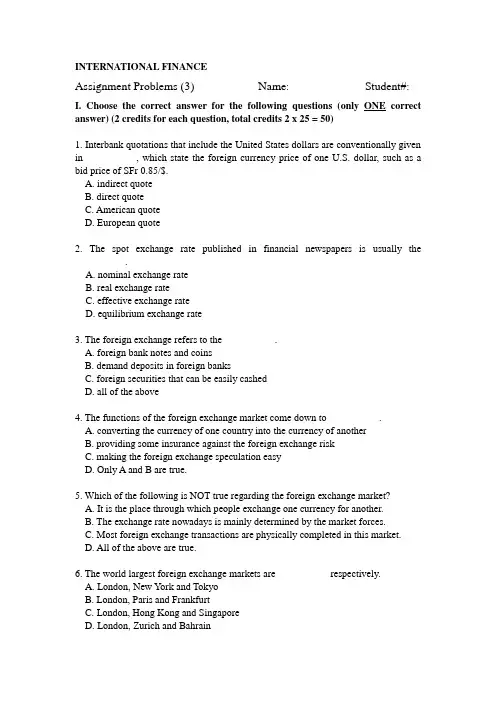
INTERNATIONAL FINANCEAssignment Problems (3) Name: Student#: I. Choose the correct answer for the following questions (only ONE correct answer) (2 credits for each question, total credits 2 x 25 = 50)1. Interbank quotations that include the United States dollars are conventionally given in __________, which state the foreign currency price of one U.S. dollar, such as a bid price of SFr 0.85/$.A. indirect quoteB. direct quoteC. American quoteD. European quote2. The spot exchange rate published in financial newspapers is usually the __________.A. nominal exchange rateB. real exchange rateC. effective exchange rateD. equilibrium exchange rate3. The foreign exchange refers to the __________.A. foreign bank notes and coinsB. demand deposits in foreign banksC. foreign securities that can be easily cashedD. all of the above4. The functions of the foreign exchange market come down to __________.A. converting the currency of one country into the currency of anotherB. providing some insurance against the foreign exchange riskC. making the foreign exchange speculation easyD. Only A and B are true.5. Which of the following is NOT true regarding the foreign exchange market?A. It is the place through which people exchange one currency for another.B. The exchange rate nowadays is mainly determined by the market forces.C. Most foreign exchange transactions are physically completed in this market.D. All of the above are true.6. The world largest foreign exchange markets are __________ respectively.A. London, New York and TokyoB. London, Paris and FrankfurtC. London, Hong Kong and SingaporeD. London, Zurich and Bahrain7. The foreign exchange market is NOT efficient because __________.A. monetary authorities dominate the foreign exchange market and everybody knows that by definition, central banks are inefficientB. commercial banks and other participants of the market do not compete with one another due to the fact that transaction takes place around the world and not in a single centralized locationC. foreign exchange dealers have different prices such as bid and ask pricesD. None of the reasons listed are correct because the foreign exchange market is an efficient market8. __________ earn a profit by a bid-ask spread on currencies they buy and sell. __________ on the other hand, earn a profit by bringing together buyers and sellers of foreign exchanges and earning a commission on each sale and purchase.A. Foreign exchange brokers; foreign exchange dealersB. Foreign exchange dealers; foreign exchange brokersC. arbitragers; speculatorsD. commercial banks; central banks9. Most foreign exchange transactions are through the U.S. dollars. If the transaction is expressed as the currencies per dollar, this is known as __________ whereas __________ are expressed as dollars per currency.A. direct quote; indirect quoteB. indirect quote; direct quoteC. European quote; American quoteD. American quote, European quote10. From the viewpoint of a Japanese investor, which of the following would be a direct quote?A. SFr 1.25/€B. $1.55/₤C. ¥ 110/€D. €0.0091/ ¥11. Which of the following is true about the foreign exchange market?A. It is a global network of banks, brokers, and foreign exchange dealers connected by electronic communications system.B. The foreign exchange market is usually located in a particular place.C. The foreign exchange rates are usually determined by the related monetary authorities.D. The main participants in this market are currency speculators from different countries.12. The extent to which the income from individual transactions is affected by fluctuations in foreign exchange values is considered to be _________.A. Translation exposureB. economic exposureC. transaction exposureD. accounting exposure13. Which of the following exchange rates is adjusted for price changes?A. nominal exchange rateB. real exchange rateC. effective exchange rateD. equilibrium exchange rate14. Suppose the exchange rate of the RMB versus U.S. dollar is ¥6.8523/$ now. If the RMB were to undergo a 10% depreciation, the new exchange rate in terms of ¥/$ would be:A. 6.1671B. 7.5375C. 6.9238D. 7.613515. At least in a U.S. MNC’s financial accounting statement, if the value of the euro depreciates rapidly against that of the dollar over a year, this would reduce the dollar value of the euro profit made by the European subsidiary. This is a typical __________.A. transaction exposureB. translation exposureC. economic exposureD. operating exposure16. A Japanese-based firm expects to receive pound-payment in 6 months. The company has a (an) __________.A. economic exposureB. accounting exposureC. long position in sterlingD. short position in sterling17 The exposure to foreign exchange risk known as Translation Exposure may be defined as __________.A. change in reported owner’s equity in consolidated financial statements caused by a change in exchange ratesB. the impact of settling outstanding obligations entered into before change in exchange rates but to be settled after change in exchange ratesC. the change in expected future cash flows arising from an unexpected change in exchange ratesD. All of the above18 When a firm deals with foreign trade or investment, it usually has foreign exchange risk exposure. So if an American firm expects to receive a dollar-paymentfrom a Chinese company in the next 30 days, the U.S. firm has the possible __________.A. economic exposureB. transaction exposureC. translation exposureD. none of the above19. In order to avoid the possible loss because of the exchange rate fluctuations, a firm that has a __________ position in foreign exchanges can __________ that position in the forward market.A. short; sellB. long; sellC. long; buyD. none of the above20. A forward contract to deliver Japanese yens for Swiss francs could be described either as __________ or __________,A. selling yens forward; buying francs forwardB. buying francs forward; buying yens forwardC. selling yens forward; selling francs forwardD. selling francs forward; buying yens forward21. Dollars are trading at S0SFr/$=SFr0.7465/$ in the spot market. The 90-day forward rate is F1SFr/$=SFr0.7432/$. So the forward __________ on the dollar in basis points is __________:A. discount, 0.0033B. discount, 33C. premium, 0.0033D. premium, 3322. If the spot rate is $1.35/€, 3-month forward rate is $1.36/€, which of the following is NOT true?A. euro is at forward premium by 100 points.B. dollar is at forward discount by 100 points.C. dollar is at forward discount by 55 points.D. euro is at forward premium by 2.96% p.a.23. If the spot C$/$ rate is 1.0305/15, forward dollar is 25/30 premium, the outright forward quote in American term should be __________.A. 1.0330 – 1.0345B. 1.0280 – 1.0285C. 0.9681 – 0.9667D. 0.9728 – 0.972324. If the spot C$/$ rate is 1.0305/15, forward dollar is 25/30 premium, the $/C$ forward quote in terms of points should be __________.A. 30/25B. 25/30C. – (23/28)D. – (28/23)25. The current U.S. dollar exchange rate is ¥85/$. If the 90-day forward dollar rate is ¥90/$, then the yen is selling at a per annum __________ of __________.A. premium; 5.88%B. discount; 5.56%C. premium; 23.52%D. discount; 22.23%II. ProblemsQuestions 1 through 10 are based on the information presented in Table 3.1. (2 credits for each question, total credits 2 x 10 = 20)Table 3.1Country Exchange rate Exchange rate CPI V olume of Volume of (2008) (2009) (2008) exports to U.S imports from U.S. Germany €0.75/$ €0.70/$ 102.5 $200m $350m Mexico Mex$11.8/$ Mex$12.20/$ 110.5 $120m $240mU.S. 105.31. The real exchange rate of the dollar against the euro in 2009 was __________.2. The real exchange rate of the dollar against the peso in 2009 was __________.3. The dollar was __________ against the euro in nominal term by __________.A. appreciated; 6.67%B. depreciated; 6.67%C. appreciated; 7.14%D depreciated; 7.14%4. The Mexican peso was __________ against the dollar in nominal term by __________.A. appreciated; 3.39%B. depreciated; 3.39%C. appreciated; 3.28%D. depreciated; 3.28%5. The volume of the German foreign trade with the U.S. was __________.6. The volume of the Mexican foreign trade with the U.S. was __________.7. Assume the U.S. trades only with the Germany and Mexico. Now if we want to calculate the dollar effective exchange rate in 2009 against a basket of currencies of euro and Mexican peso, the weight assigned to the euro should be __________.8. The weight assigned to the peso should be __________.9. Assume the 2008 is the base year. The dollar effective exchange rate in 2009 was __________.10. Was the dollar generally stronger or weaker in 2009 according to your calculation?11. The following exchange rates are available to you.Fuji Bank ¥80.00/$United Bank of Switzerland SFr0.8900/$Deutsche Bank ¥95.00/SFrAssume you have an initial SFr10 million. Can you make a profit via triangular arbitrage? If so, show steps and calculate the amount of profit in Swiss francs. (8 credits)12. If the dollar appreciates 1000% against the ruble, by what percentage does the ruble depreciate against the dollar? (5 credits)13. As a percentage of an arbitrary starting amount, about how large would transactions costs have to be to make arbitrage between the exchange rates S SFr/$= SFr1.7223/$, S$/¥= $0.009711/¥, and S¥/SFr = ¥61.740/SFr unprofitable? Explain. (7 credits14. You are given the following exchange rates:S¥/A$ = 67.05 – 68.75S£/A$ = 0.3590 – 0.3670Calculate the bid and ask rate of S¥/£: (5 credits)15. Suppose the spot quotation on the Swiss franc (CHF) in New York is USD0.9442 –52 and the spot quotation on the Euro (EUR) is USD1.3460 –68. Compute the percentage bid-ask spreads on the CHF/EUR quote. ( 5 credits)Answers to Assignment Problems (3)Part II1. 0.70 x (105.3/102.5) = 0.7 x 1.0273 = 0.71912. 12.2 x (105.3/110.5) = 12.2 x .9529 = 11.62593. B (0.7 /.75) – 1 = -6.67%4. D (1/12.2)/(1/11.8) – 1 = -3.28%5. 5506. 3607. 550/910 = 60.44%8. 360/910 = 39.569. (0.70/0.75)(60.44%) + (12.2/11.8)(39.56%) = .5641 + 0.4090 = .9731 = 97.31%10. weaker, because dollar depreciated by 2.69%.11. Since S¥/$S$/SFr S SFr/¥= 80 x 1/0.8900 x 1/95.00 = 0.946186 < 1, there is an arbitrage opportunity.Steps:①Buy ¥ from Deutsche Bank, SFr10 million x 95.00 = ¥950 million②Buy $from Fuji Bank, $950 m / 80.00 = $11.875 m③Buy SFr from UBS, $11.875 x 0.8900 = SFr10.56875 mProfit (ignoring transaction fees):SFr10.56875 – SFr10 = 0.56875 million = 568,75012. (x – 1) = 1000%; 1/11 – 1 = 90.9%13. S SFr/$ S$/¥S¥/SFr = SFr1.7223/$ x $0.009711/¥ x ¥61.740/SFr = 1.0326If transaction costs exceed $0.0326 (3.26%), the arbitrage is unprofitable.14. Given: S¥/A$ = 67.05 – 68.75S£/A$ = 0.3590 – 0.3670So, S¥/₤ = 67.05/0.3670 = 182.70 (bid)S£/₤ = 68.75/0.3590 = 191.50 (ask)15. Given: USD0.9442 – 52/SFrUSD1.3460 – 68/SFrSo, S SRr/€ = 1.3460/0.9452 =1.424 (bid)S SFr/€ = 1.3468/0.9442 = 1.4264 (ask)。
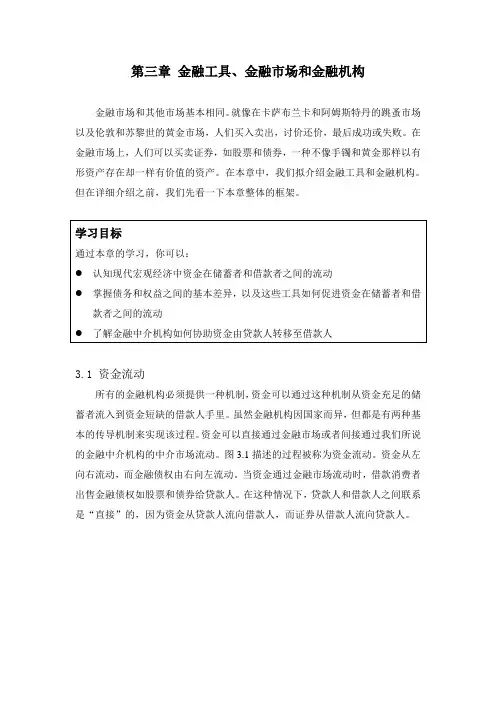
第三章金融工具、金融市场和金融机构金融市场和其他市场基本相同。
就像在卡萨布兰卡和阿姆斯特丹的跳蚤市场以及伦敦和苏黎世的黄金市场,人们买入卖出,讨价还价,最后成功或失败。
在金融市场上,人们可以买卖证券,如股票和债券,一种不像手镯和黄金那样以有形资产存在却一样有价值的资产。
在本章中,我们拟介绍金融工具和金融机构。
但在详细介绍之前,我们先看一下本章整体的框架。
3.1 资金流动所有的金融机构必须提供一种机制,资金可以通过这种机制从资金充足的储蓄者流入到资金短缺的借款人手里。
虽然金融机构因国家而异,但都是有两种基本的传导机制来实现该过程。
资金可以直接通过金融市场或者间接通过我们所说的金融中介机构的中介市场流动。
图3.1描述的过程被称为资金流动。
资金从左向右流动,而金融债权由右向左流动。
当资金通过金融市场流动时,借款消费者出售金融债权如股票和债券给贷款人。
在这种情况下,贷款人和借款人之间联系是“直接”的,因为资金从贷款人流向借款人,而证券从借款人流向贷款人。
金融中介机构图3.1 从贷款人向借款人的资金流向当资金通过中介机构流动时,这个过程就是“间接”的。
这是因为贷款人购买金融中介机构发行的金融债权,然后,金融中介机构购买借款人发行的金融债权。
例如,贷款人(储蓄者)购买银行存单,而银行可以发放商业贷款,就像是购买一个商业公司的商业票据(如欠条)。
这里贷款人不直接购买商业贷款,而是以存款的形式投资于银行间接地提供资金。
此外,金融中介机构从金融市场购买证券,例如一家人寿保险公司购买公司债券。
因此,你会注意到在图3.1中,金融中介机构和金融市场之间有一个箭头。
通过各种各样的方法、金融工具和金融机构,金融系统将数百万的资金转移到需要更多资金的借款人手中。
资金可以通过金融市场和金融中介市场这两个渠道,从资金盈余者手里转移到资金需求者手里。
储户贷款者将获利,因为他们可以从借出的资金中赚取利息和股息红利。
借款消费者也将受益,因为他们获得了投资所需的资金,否则将无法进行融资(可能投资赚取的收益超过支付的利息)。
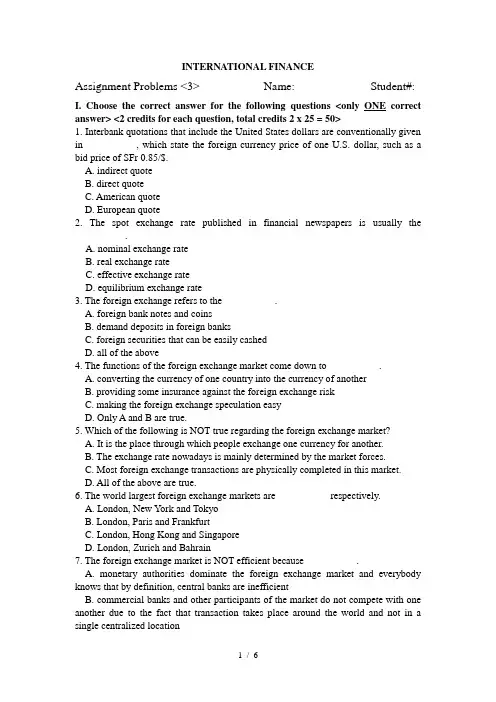
INTERNATIONAL FINANCEAssignment Problems <3> Name: Student#: I. Choose the correct answer for the following questions <only ONE correct answer> <2 credits for each question, total credits 2 x 25 = 50>1. Interbank quotations that include the United States dollars are conventionally given in __________, which state the foreign currency price of one U.S. dollar, such as a bid price of SFr 0.85/$.A. indirect quoteB. direct quoteC. American quoteD. European quote2. The spot exchange rate published in financial newspapers is usually the __________.A. nominal exchange rateB. real exchange rateC. effective exchange rateD. equilibrium exchange rate3. The foreign exchange refers to the __________.A. foreign bank notes and coinsB. demand deposits in foreign banksC. foreign securities that can be easily cashedD. all of the above4. The functions of the foreign exchange market come down to __________.A. converting the currency of one country into the currency of anotherB. providing some insurance against the foreign exchange riskC. making the foreign exchange speculation easyD. Only A and B are true.5. Which of the following is NOT true regarding the foreign exchange market?A. It is the place through which people exchange one currency for another.B. The exchange rate nowadays is mainly determined by the market forces.C. Most foreign exchange transactions are physically completed in this market.D. All of the above are true.6. The world largest foreign exchange markets are __________ respectively.A. London, New York and TokyoB. London, Paris and FrankfurtC. London, Hong Kong and SingaporeD. London, Zurich and Bahrain7. The foreign exchange market is NOT efficient because __________.A. monetary authorities dominate the foreign exchange market and everybody knows that by definition, central banks are inefficientB. commercial banks and other participants of the market do not compete with one another due to the fact that transaction takes place around the world and not in a single centralized locationC. foreign exchange dealers have different prices such as bid and ask pricesD. None of the reasons listed are correct because the foreign exchange market is an efficient market8. __________ earn a profit by a bid-ask spread on currencies they buy and sell. __________ on the other hand, earn a profit by bringing together buyers and sellers of foreign exchanges and earning a commission on each sale and purchase.A. Foreign exchange brokers; foreign exchange dealersB. Foreign exchange dealers; foreign exchange brokersC. arbitragers; speculatorsD. commercial banks; central banks9. Most foreign exchange transactions are through the U.S. dollars. If the transaction is expressed as the currencies per dollar, this is known as __________ whereas __________ are expressed as dollars per currency.A. direct quote; indirect quoteB. indirect quote; direct quoteC. European quote; American quoteD. American quote, European quote10. From the viewpoint of a Japanese investor, which of the following would be a direct quote?A. SFr 1.25/€B. $1.55/₤C. ¥ 110/€D. €0.0091/ ¥11. Which of the following is true about the foreign exchange market?A. It is a global network of banks, brokers, and foreign exchange dealers connected by electronic communications system.B. The foreign exchange market is usually located in a particular place.C. The foreign exchange rates are usually determined by the related monetary authorities.D. The main participants in this market are currency speculators from different countries.12. The extent to which the income from individual transactions is affected by fluctuations in foreign exchange values is considered to be _________.A. Translation exposureB. economic exposureC. transaction exposureD. accounting exposure13. Which of the following exchange rates is adjusted for price changes?A. nominal exchange rateB. real exchange rateC. effective exchange rateD. equilibrium exchange rate14. Suppose the exchange rate of the RMB versus U.S. dollar is ¥6.8523/$ now. If the RMB were to undergo a 10% depreciation, the new exchange rate in terms of¥/$ would be:A. 6.1671B. 7.5375C. 6.9238D. 7.613515. At least in a U.S. MNC’s financial accounting statement, if the value of the euro depreciates rapidly against that of the dollar over a year, this would reduce the dollar value of the euro profit made by the European subsidiary. This is a typical __________.A. transaction exposureB. translation exposureC. economic exposureD. operating exposure16. A Japanese-based firm expects to receive pound-payment in 6 months. The company has a <an> __________.A. economic exposureB. accounting exposureC. long position in sterlingD. short position in sterling17 The exposure to foreign exchange risk known as Translation Exposure may be defined as __________.A. change in reported owner’s equity in consolidated financial statements caused by a change in exchange ratesB. the impact of settling outstanding obligations entered into before change in exchange rates but to be settled after change in exchange ratesC. the change in expected future cash flows arising from an unexpected change in exchange ratesD. All of the above18 When a firm deals with foreign trade or investment, it usually has foreign exchange risk exposure. So if an American firm expects to receive a dollar-payment from a Chinese company in the next 30 days, the U.S. firm has the possible __________.A. economic exposureB. transaction exposureC. translation exposureD. none of the above19. In order to avoid the possible loss because of the exchange rate fluctuations, a firm that has a __________ position in foreign exchanges can __________ that position in the forward market.A. short; sellB. long; sellC. long; buyD. none of the above20. A forward contract to deliver Japanese yens for Swiss francs could be described either as __________ or __________,A. selling yens forward; buying francs forwardB. buying francs forward; buying yens forwardC. selling yens forward; selling francs forwardD. selling francs forward; buying yens forward21. Dollars are trading at S0SFr/$=SFr0.7465/$ in the spot market. The 90-day forward rate is F1SFr/$=SFr0.7432/$. So the forward __________ on the dollar in basis points is __________:A. discount, 0.0033B. discount, 33C. premium, 0.0033D. premium, 3322. If the spot rate is $1.35/€, 3-month forward rate is $1.36/€, which of the following is NOT true?A. euro is at forward premium by 100 points.B. dollar is at forward discount by 100 points.C. dollar is at forward discount by 55 points.D. euro is at forward premium by 2.96% p.a.23. If the spot C$/$ rate is 1.0305/15, forward dollar is 25/30 premium, the outright forward quote in American term should be __________.A. 1.0330 – 1.0345B. 1.0280 – 1.0285C. 0.9681 – 0.9667D. 0.9728 – 0.972324. If the spot C$/$ rate is 1.0305/15, forward dollar is 25/30 premium, the $/C$ forward quote in terms of points should be __________.A. 30/25B. 25/30C. – <23/28>D. – <28/23>25. The current U.S. dollar exchange rate is ¥85/$. If the 90-day forward dollar rate is ¥90/$, then the yen is selling at a per annum __________ of __________.A. premium; 5.88%B. discount; 5.56%C. premium; 23.52%D. discount; 22.23%II. ProblemsQuestions 1 through 10 are based on the information presented in Table 3.1.<2 credits for each question, total credits 2 x 10 = 20>Table 3.1Country Exchange rate Exchange rate CPI V olume of V olume of<2008> <2009> <2008> exports to U.S imports from U.S. Germany €0.75/$ €0.70/$ 102.5 $200m $350m MexicoMex$11.8/$ Mex$12.20/$ 110.5 $120m $240mU.S. 105.31. The real exchange rate of the dollar against the euro in 2009 was __________.2. The real exchange rate of the dollar against the peso in 2009 was __________.3. The dollar was __________ against the euro in nominal term by __________.A. appreciated; 6.67%B. depreciated; 6.67%C. appreciated; 7.14%D depreciated; 7.14%4. The Mexican peso was__________ against the dollar in nominal term by __________.A. appreciated; 3.39%B. depreciated; 3.39%C. appreciated; 3.28%D. depreciated; 3.28%5. The volume of the German foreign trade with the U.S. was __________.6. The volume of the Mexican foreign trade with the U.S. was __________.7. Assume the U.S. trades only with the Germany and Mexico. Now if we want to calculate the dollar effective exchange rate in 2009 against a basket of currencies of euro and Mexican peso, the weight assigned to the euro should be __________.8. The weight assigned to the peso should be __________.9. Assume the 2008 is the base year. The dollar effective exchange rate in 2009 was __________.10. Was the dollar generally stronger or weaker in 2009 according to your calculation?11. The following exchange rates are available to you.Fuji Bank¥80.00/$United Bank of Switzerland SFr0.8900/$Deutsche Bank ¥95.00/SFrAssume you have an initial SFr10 million. Can you make a profit via triangular arbitrage? If so, show steps and calculate the amount of profit in Swiss francs. <8 credits>12. If the dollar appreciates 1000% against the ruble, by what percentage does the ruble depreciate against the dollar?<5 credits>13. As a percentage of an arbitrary starting amount, about how large would transactions costs have to be to make arbitrage between the exchange rates S SFr/$= SFr1.7223/$, S$/¥= $0.009711/¥, and S¥/SFr = ¥61.740/SFr unprofitable? Explain. <7 credits14. You are given the following exchange rates:S¥/A$ = 67.05 – 68.75S£/A$ = 0.3590 – 0.3670Calculate the bid and ask rate of S¥/£:<5 credits>15. Suppose the spot quotation on the Swiss franc <CHF> in New York is USD0.9442 –52 and the spot quotation on the Euro <EUR> is USD1.3460 –68. Compute the percentage bid-ask spreads on the CHF/EUR quote.<5 credits>Answers to Assignment Problems <3>1. 0.70 x <105.3/102.5> = 0.7 x 1.0273 = 0.71912. 12.2 x <105.3/110.5> = 12.2 x .9529 = 11.62593. B <0.7 /.75> – 1 = -6.67%4. D <1/12.2>/<1/11.8> – 1 = -3.28%5. 5506. 3607. 550/910 = 60.44%8. 360/910 = 39.569. <0.70/0.75><60.44%> + <12.2/11.8><39.56%> = .5641 + 0.4090 = .9731 = 97.31%10. weaker, because dollar depreciated by 2.69%.11. Since S¥/$S$/SFr S SFr/¥= 80 x 1/0.8900 x 1/95.00 = 0.946186 < 1, there is an arbitrage opportunity.Steps:①Buy ¥ from Deutsche Bank, SFr10 million x 95.00 = ¥950 million②Buy $from Fuji Bank, $950 m / 80.00 = $11.875 m③Buy SFr from UBS, $11.875 x 0.8900 = SFr10.56875 mProfit <ignoring transaction fees>:SFr10.56875 – SFr10 = 0.56875 million = 568,75012.<x – 1> = 1000%; 1/11 – 1 = 90.9%13. S SFr/$ S$/¥S¥/SFr= SFr1.7223/$ x $0.009711/¥ x ¥61.740/SFr = 1.0326If transaction costs exceed $0.0326 <3.26%>, the arbitrage is unprofitable.14.Given: S¥/A$ = 67.05 – 68.75S£/A$ = 0.3590 – 0.3670So, S¥/₤ = 67.05/0.3670 = 182.70 <bid>S£/₤ = 68.75/0.3590 = 191.50 <ask>15. Given: USD0.9442 – 52/SFrUSD1.3460 – 68/SFrSo, S SRr/€ =1.3460/0.9452 =1.424 <bid>S SFr/€ = 1.3468/0.9442 = 1.4264 <ask>Bid-ask margin = <1.4264 – 1.424> / 1.4264 = 0.1683%。

Chapter 1:9. Net debtor nation of the amount $25 billion.10. a. Merchandise trade balance, $75 billion deficit. Services balance, $60 billion surplus. Goods and services balance, $15 billion deficit. Investment income balance, $5 billion surplus. Unilateral transfers balance, $20 billion deficit. Current account balance, $30 billion deficit.b. Current account. The current account deficit implies that the United States is anet-demander of funds from the rest of the world.11. a-debit; b-credit; c-credit; d-debit; e-debit; f-debit; g-credit; h-debit; i-debit.Chapter 2:1. An arbitrager could purchase 3 francs with $1, purchase 6 schilling with 3 francs, and sell 6schilling for $1.50. Ignoring transaction costs, the arbitrager realizes a $0.50 profit on the transactions.2. a. The U.S. speculator should sell francs today for delivery in 3 months at today'sforward rate of the franc, which equals $0.50.b. After 3 months, if the franc's spot rate is $0.40, the speculator can purchase francsat the price of $0.40 each and deliver them for the previously contracted rate of$0.50 per franc; the speculator realizes a profit of $0.10 on each franc which theforward contract specifies. If the franc's spot rate after 3 months is $0.60, thespeculator must purchase francs at a price of $0.60 per franc and resell them at aprice of $0.50 per franc; the speculator would suffer losses of $0.10 on each francspecified in the forward contract. If the franc's spot rate after 3 months is $0.50,the speculator realizes neither a profit nor a loss on the transaction.3. a. The U.S. importer can cover her foreign exchange risk by purchasing 20,000 poundsfor three-month delivery at today's three-month forward rate of $1.75 per pound.The importer is willing to pay 5 cents more per pound than today's spot rate toguard against the possibility that the spot rate in three months will exceed $1.70 perpound. In three months, when her payments are due, the importer will pay$35,000 and get the 20,000 pounds needed for payment, irrespective of what thepound's spot rate is at that time.b. If the spot rate of the pound in three months is $1.80 per pound, and the U.S.importer does not obtain forward cover, she must pay $36,000 for the 20,000pounds; this amount exceeds by $1000 the cost of the pounds she incurs byhedging.4. a. 1.7090, 1.7105, 1.7084, 1.7099, 1.7081, 1.7096, 1.7090, 1.7103.b. $0.5851 per franc, $1.7090 francs per dollar.c. Depreciated, appreciated.d. $58.51, 170.9 francs.e. The 30-day forward franc was at a premium of $.0002 which equals 0.4 percent onan annual basis. The 90-day forward franc was at a premium of $.0003 whichequals 0.2 percent on an annual basis.5. Arbitragers will buy pounds in New York, at $1.69 per pound, and sell pounds in London, at$1.71 per pound, thus making a profit of 2 cents on each pound. As pounds are bought in New York, their prices rises; as pounds are sold in London, their price falls. When the dollar price of the pound equalizes in the financial centers, the profitability of arbitrage ceases and the practice stops.6. a. The U.S. investor would purchase pounds on the spot market at $2 per pound, anduse the pounds to buy U.K. treasury bills in London; he would earn 4 percentannually more than he would if he had purchased U.S. treasury bills in New York.b. Yes, by 0.5 percent.7. a. $1.50 per pound. 30 pounds are purchased at a cost of $45.b. Excess supply, 20 pounds. Dollar price of the pound decreases, decrease, increase.c. E xcess demand, 20 pounds. Dollar price of the pound increases, increase, decrease.Chapter 3:1. a. - 2 percent in the U.S., 2 percent in the U.K.b. Investment would flow from the U.S. to the U.K.c. T he dollar would depreciate against the pound.2. The dollar's exchange rate will:a. Depreciateb. Appreciatec. Appreciated. Appreciatee. Depreciatef. Depreciateg. Appreciate3. a. Dollar depreciates by 10 percent, to approximately $0.55 per franc.b. Dollar appreciates by 10 percent, to approximately $0.45 per franc.c. Dollar appreciates by 15 percent, to approximately $0.43 per franc.d. Dollar depreciates by 5 percent, to approximately $0.53 per franc.4. In the short run, changes in exchange rates are caused by relative interest rates and expectedchanges in exchange rates.5.More expensive, less expensive, increased, decreased7. a. Falseb. Truec. TrueChapter 5:1. a. Export quantity 1000Export price $3000Export receipts $3 millionImport quantity 150Import price $20,000Import payments $3 millionTrade balance $0b. The dollar depreciation improves (worsens) the U.S. trade balance when the sum ofthe export-demand elasticity and the import-demand elasticity are greater (less)than 1.0.c. Because the sum of the export-demand elasticity and the import-demand elasticityare less than 1.0, the U.S. trade balance will worsen.3. The 50 percent dollar appreciation results in a less-than 50 percent increase in the firm'sproduction cost in terms of the peso.7. The 50 percent dollar appreciation results in a 50 percent increase in the firm's production costin terms of the peso.。
